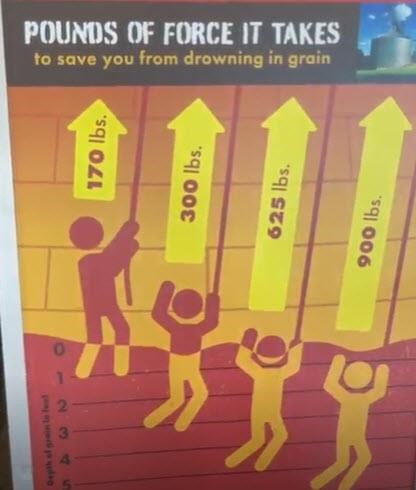The amount of force required to pull someone from a grain bin is underestimated.
By Denise Faguy
Farms.com
While at the 2024 National Farm Machinery Show in Louisville Kentucky, Farms.com spoke with Dale Dobson, Safety Administrator with the Kentucky Department of Agriculture about grain bin safety.
This week is Grain Bin Safety Week, a week dedicated to promoting a zero-entry mentality in grain bins and providing life-saving resources.
Engulfment in grain bins can happen incredibly fast, and once they have fallen in, farmers are at risk of being submerged within seconds. The rate of such grain bin mishaps has risen 45% since 2021, emphasizing the need for preparedness.
Grain Bin Safety Week not only raises awareness of the hazards associated with grain bins but also equips those on the front lines with the capabilities to respond swiftly and effectively, marking significant strides towards enhancing safety in the agricultural sector.
Grain bin accidents are preventable. Dobson said the first rule when entering a grain bin, is let someone know you are going into the bin.
The next most important step is to wear a harness, or to be roped off and tied off before entering the bin. “Get a safety harness,” pleads Dobson. “It is less than $200, you can get them many places including on Amazon or from Fastenal.”
But if someone does fall into the bin, Dobson showed the Farms.com team how the “Great Wall Tube” or a turtle plastic tube can save lives. “It’s like a parachute, somebody caught in the grain you climb, bend, pop it out, we get it started around them, the person can start breathing again,” Dobson explained. Because when a person is trapped in a grain bin, the grain is crushing or rupturing their internal organs, such as spleen, liver, kidneys.
Dobson explained that when a farmer falls into a bin, bystanders often don’t call 911 immediately because they are embarrassed. Instead, they go into the bin to try to pull the person out themselves, and then they fall into the bin as well.
What they do not understand is the amount of force that is required to pull someone out that is drowning in a grain bin. As would-be rescuers are trying to pull the victim up, the grain is forcing them down, and now the would-be rescuer’s weight is added to the equation, “So as we're pulling up, we're forcing down and we hurt them (the victim).”

The first step in rescuing someone is to put something to separate them from the crushing grain, something like the “Great Wall Tube” or the turtle plastic tube – or whatever you have that is handy.
But before you help others, you must ensure you are tied off.
“Like I said, we got some of the best farmers in the world, we got some of the best rescuers in the world, and I'm proud to be walking on both sides of that street,” concluded Dobson.
To learn more about Grain Bin Safety, please visit GrainBinSafetyWeek.com.
Watch this video about Grain Safety with Dale Dobson.